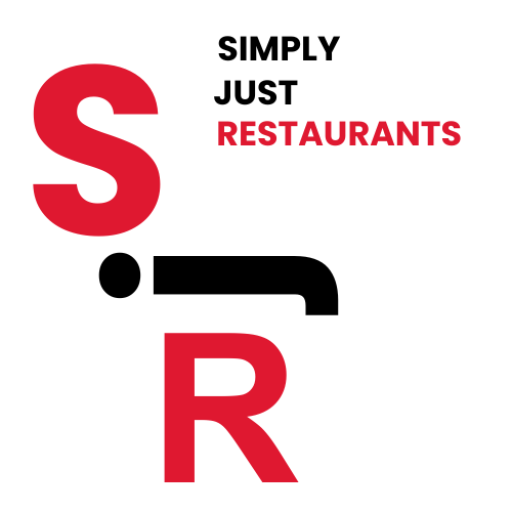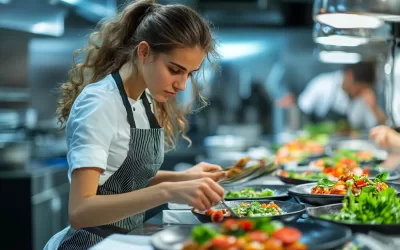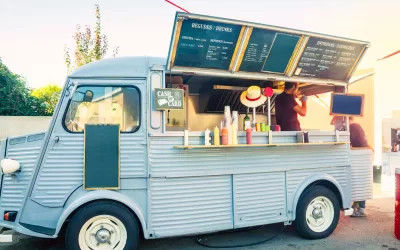- Introduction
- 1. Sustainability and Eco-Friendly Designs
- 2. Minimalism with a Twist
- 3. Technology Integration
- 4. Fusion of Local and Global Influences
- 5. Retro and Vintage Revival
- 6. Bold Use of Colors and Textures
- 7. Multi-Sensory Dining Experiences
- 8. Indoor-Outdoor Integration
- 9. Comfort and Relaxation
- 10. Pop-Up and Hybrid Spaces
- 11. Storytelling Through Design
- conclusion
Introduction
Restaurant design in 2024 is a reflection of evolving consumer preferences, technological advancements, and heightened awareness of sustainability. As the dining experience continues to transform, restaurant owners, architects, and designers are innovating to create spaces that offer not just a meal but a memorable and engaging experience. This comprehensive exploration of restaurant design trends in 2024 delves into various elements that are shaping the industry, from aesthetics and material choices to technological integration and sustainability.
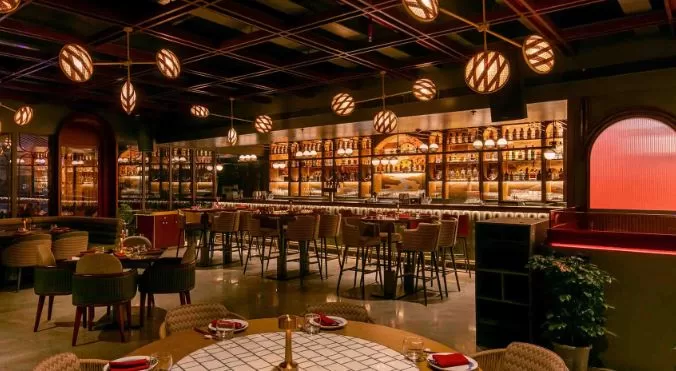
1. Sustainability and Eco-Friendly Designs
-
Sustainability remains a cornerstone of design in 2024. As consumers become more environmentally conscious, restaurants are increasingly expected to reflect those values. Sustainable design isn’t just a trend; it’s a necessary evolution that aligns with global efforts to reduce carbon footprints.
-
Recycled and Natural Materials: Restaurants are moving away from synthetic materials in favor of those that can be sustainably sourced or recycled. Reclaimed wood, bamboo, and cork are common choices for furniture, walls, and floors. This not only minimizes environmental impact but also gives the space a natural, organic feel that many diners find appealing.
-
Energy Efficiency: Lighting, heating, and cooling systems are designed with energy efficiency in mind. LED lighting, which consumes less power and lasts longer, is the industry standard. Solar panels and other renewable energy sources are also becoming more common, with restaurant owners keen to reduce energy consumption and promote their commitment to sustainability.
-
Greenery and Biophilic Design: Nature is increasingly being integrated into indoor restaurant environments. Vertical gardens, living walls, and indoor plants bring nature into the dining space, improving air quality and providing a calming ambiance. This connection to nature, known as biophilic design, is associated with positive mental well-being, which can enhance the overall dining experience.
-
Sustainable Tableware and Packaging: Beyond the design of the restaurant itself, the focus on sustainability extends to the utensils, dishware, and packaging used in the service. Restaurants are moving away from single-use plastics and opting for biodegradable or reusable options. Many establishments now offer take-out containers made from plant-based materials, ensuring that even the after-dining experience is environmentally friendly.
-
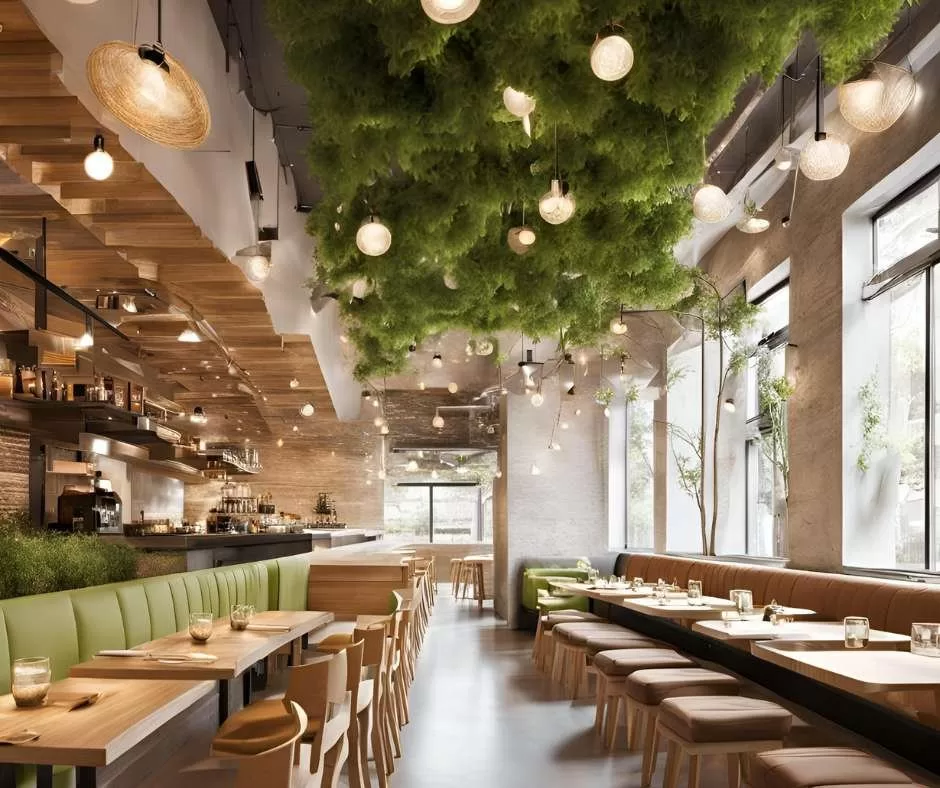
2. Minimalism with a Twist
Minimalism, a design movement characterized by simplicity and clean lines, continues to thrive in restaurant design, but with more personalized and creative interpretations in 2024. Rather than the stark, cold minimalism of past decades, today’s minimalist spaces are warmer and more inviting.
-
Open and Airy Spaces: The concept of “less is more” manifests in open floor plans and unobstructed sightlines. Spacious layouts promote a sense of tranquility and order. Restaurant designers are focusing on making spaces feel uncluttered while ensuring they remain functional and comfortable.
-
Neutral Palettes with Bold Accents: While minimalist designs are often associated with neutral color schemes—beige, gray, off-white—2024’s minimalism integrates bold accents in the form of statement walls, vibrant art pieces, or colorful furniture. This careful use of color adds personality and visual interest without overwhelming the simplicity of the space.
-
Flexible Seating Arrangements: Flexibility is key to modern restaurant design. Instead of rigid seating arrangements, multi-functional furniture that can be easily reconfigured to accommodate different group sizes or purposes is trending. For instance, modular seating or movable dividers allow for more private dining when necessary or can be re-arranged for larger group events.
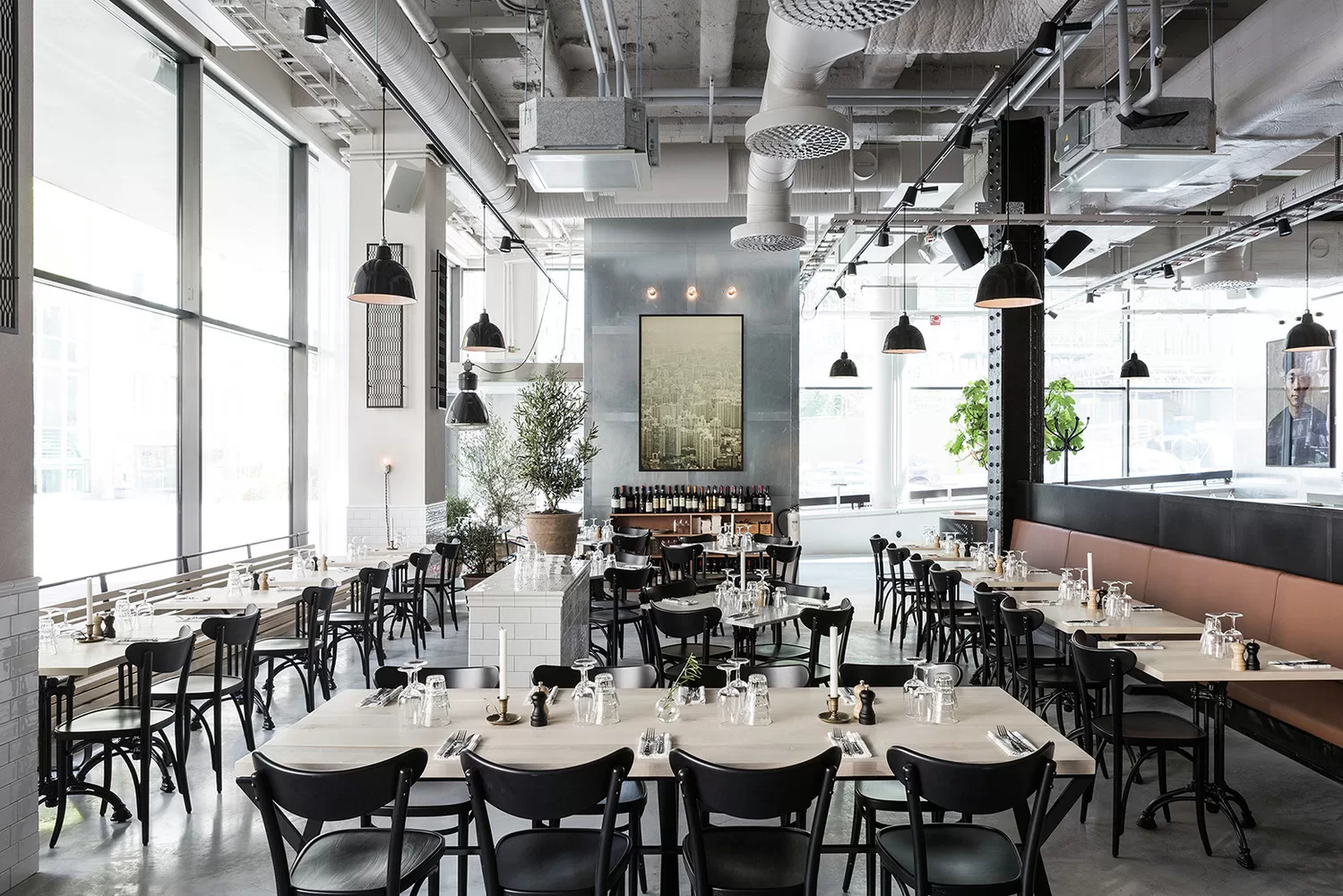
3. Technology Integration
-
Technology plays a significant role in shaping the restaurant experience in 2024. From operational efficiency to customer interaction, smart technologies are transforming the way restaurants are designed and managed.
-
Self-Ordering Systems and Contactless Payments: Many restaurants are implementing self-service kiosks or tablet-based ordering systems, allowing guests to browse the menu, customize their orders, and even pay without interacting with a server. These systems not only improve efficiency but also cater to customers who prefer a more autonomous dining experience. Contactless payment methods—such as Apple Pay, Google Wallet, or QR code-based systems—are standard in most restaurants, enabling fast, secure transactions.
-
Smart Tables and Interactive Menus: Dining tables equipped with digital touch screens or augmented reality (AR) features are gaining traction. These interactive surfaces can display menus, allow customers to play games while waiting, or even provide entertainment such as live social media feeds or customized visuals. This level of engagement adds an extra layer to the dining experience, turning a meal into an interactive event.
-
Virtual Waiting Systems and Mobile Apps: Customers increasingly expect convenience and efficiency when dining out, leading to the rise of virtual queuing systems. Rather than waiting in line at the restaurant, patrons can check in via mobile apps and receive updates on their table status, minimizing physical waiting time. These systems enhance the guest experience by providing transparency and reducing frustration during busy dining periods.
-
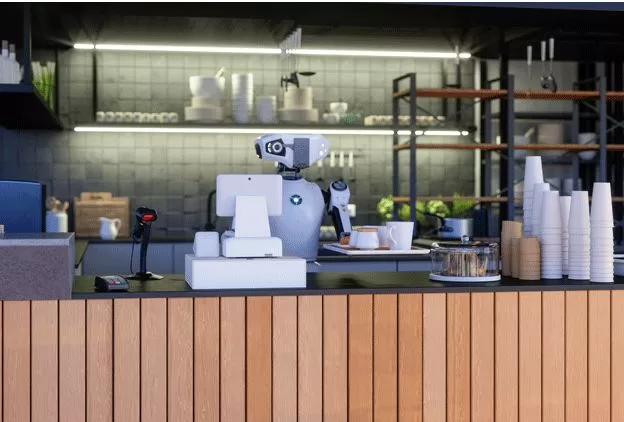
4. Fusion of Local and Global Influences
-
Cultural fusion in restaurant design is becoming more prevalent as globalization influences cuisine and dining environments. In 2024, many restaurants aim to blend local craftsmanship with global trends to create unique, eclectic spaces.
-
Showcasing Local Art and Craftsmanship: Incorporating art and design elements from the local community helps to ground the restaurant in its geographical context. For example, restaurants may feature murals or installations by local artists, or use handcrafted furniture made by artisans in the region. This not only supports local talent but also creates a connection between the restaurant and its surrounding community.
-
Global Design Aesthetics: While local elements are important, many restaurants are also incorporating global design influences to create a fusion of styles. From Scandinavian minimalism to Japanese wabi-sabi, global trends are being adapted and blended with local aesthetics to create visually stimulating and diverse dining spaces.
-
Open Kitchens and Culinary Showcases: A trend that continues to gain popularity is the open kitchen design, where diners can observe chefs in action. This not only enhances transparency but also allows customers to feel more connected to the culinary process. In some restaurants, this takes the form of live cooking stations or chef’s tables where diners can interact directly with the kitchen staff.
-
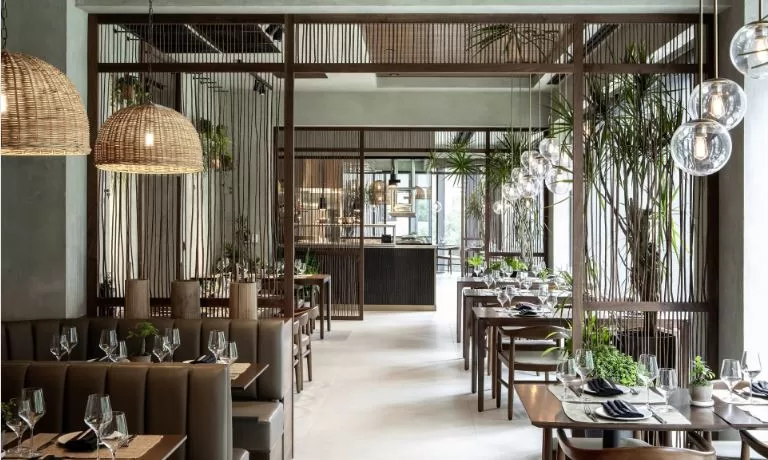
5. Retro and Vintage Revival
Nostalgia plays a powerful role in design, and in 2024, vintage and retro aesthetics are seeing a resurgence, often with a modern twist. Restaurants that draw on past design movements create a sense of familiarity while offering a fresh take on classic styles.
-
Mid-Century Modern: A design movement that originated in the mid-20th century, Mid-Century Modern has clean lines, organic forms, and a mix of both natural and man-made materials. Restaurants inspired by this style often feature bold, geometric patterns, sleek furniture, and warm wood accents. The balance between vintage elements and contemporary sensibilities makes Mid-Century Modern a versatile choice.
-
Art Deco Revival: Known for its luxurious materials, geometric designs, and bold color schemes, Art Deco is experiencing a revival in high-end restaurants. Marble countertops, brass fixtures, and velvet upholstery create a sophisticated, opulent ambiance. Paired with modern lighting and updated color palettes, Art Deco interiors can feel both timeless and trendy.
-
Vintage Lighting: Lighting is often the focal point in retro-inspired designs. From industrial-style Edison bulbs to ornate chandeliers, vintage lighting adds warmth and character. Modern versions of these fixtures incorporate energy-efficient technologies, ensuring that the aesthetics don’t compromise functionality.
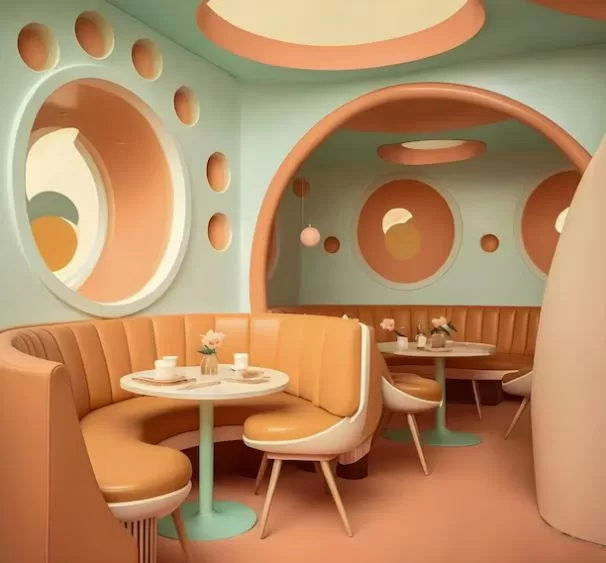
6. Bold Use of Colors and Textures
-
Restaurants in 2024 are not shying away from bold design choices when it comes to color and texture. These elements are being used to create dynamic, stimulating environments that engage customers on a sensory level.
-
Vibrant Accents: Bright, bold colors—such as deep blues, emerald greens, or rich reds—are being used as accents to add depth and personality to otherwise neutral spaces. These accent colors may appear on a feature wall, in the upholstery of seating, or in decorative elements like throw pillows and artwork.
-
Texture Play: A variety of textures are being combined to create visual and tactile contrast. Smooth surfaces like marble or polished concrete are juxtaposed with rougher textures like reclaimed wood, woven fabrics, or raw brick. This layering of textures adds complexity and interest, making the space feel more dynamic.
-
Statement Art Pieces: Large murals, graffiti art, or oversized sculptures are often used to make a bold statement. These pieces serve as focal points within the restaurant and can help define the identity of the space.
-
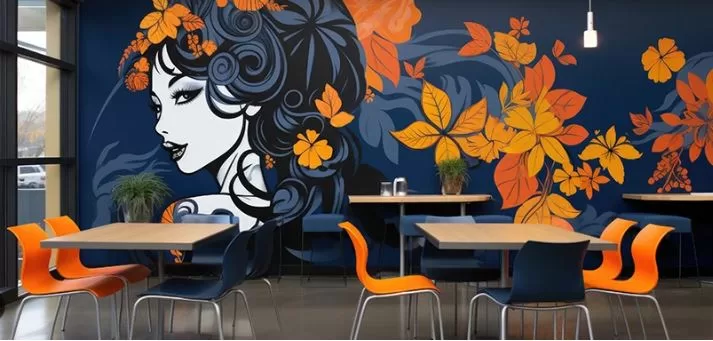
7. Multi-Sensory Dining Experiences
Designers are increasingly thinking beyond aesthetics, incorporating multiple sensory elements to create immersive dining experiences. These multi-sensory environments engage sight, sound, smell, and even touch to leave a lasting impression on diners.
-
Themed Restaurants: Some restaurants are embracing fully immersive themes, where everything from the decor to the menu is designed around a central concept. For example, a nature-themed restaurant might use natural materials, soft ambient lighting, and soothing soundscapes to create a calming environment. These themed spaces transport diners to another world, offering a complete sensory experience.
-
Interactive Visuals and Projection Mapping: Digital projections and AR are being used to create dynamic, ever-changing environments. For example, projection mapping can transform a dining room into a forest, a cityscape, or even an abstract art installation. These visuals can change throughout the course of the meal, keeping the dining experience fresh and exciting.
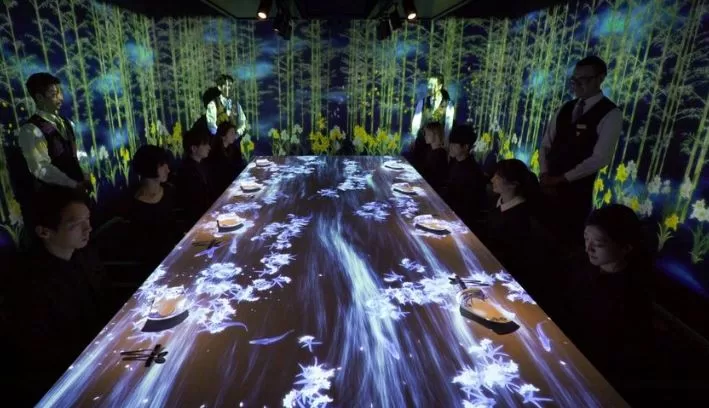
8. Indoor-Outdoor Integration
Blurring the lines between indoor and outdoor spaces continues to be a popular trend, particularly in areas where year-round outdoor dining is feasible. Restaurants are designing spaces that seamlessly flow from inside to outside, providing flexible seating options and enhancing the overall dining experience.
-
Al Fresco Dining Areas: Outdoor patios and rooftop terraces remain highly sought after, particularly in urban areas where space is at a premium. These outdoor spaces often feature comfortable lounge seating, fire pits, and greenery to create a relaxed, casual atmosphere.
-
Retractable Roofs and Walls: To accommodate changing weather conditions, many restaurants are installing retractable roofs or sliding glass walls that can be opened or closed depending on the climate. This flexibility allows restaurants to offer outdoor dining year-round, maximizing their use of space.
-
Natural Lighting: Large windows, skylights, and glass walls bring natural light into the dining space, reducing the need for artificial lighting during the day. Natural light not only improves the ambiance but also contributes to a more eco-friendly design.
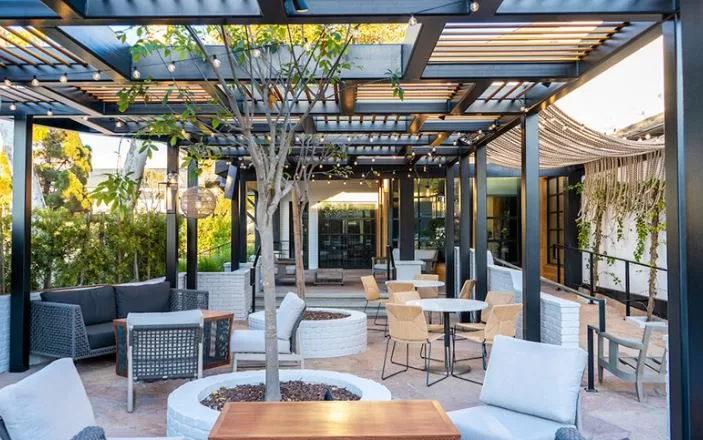
9. Comfort and Relaxation
Comfort is paramount in 2024’s restaurant designs, as diners increasingly seek spaces where they can relax and unwind. Restaurants are being designed to feel like extensions of living rooms, with soft seating, cozy nooks, and intimate lighting.
-
Lounge Areas: Many restaurants are incorporating lounge-style seating into their designs, with plush sofas, low tables, and soft lighting. These areas create a more informal, relaxed vibe, encouraging customers to linger over drinks or small plates.
-
Private Dining Nooks: Intimacy is another key consideration in modern restaurant design. Private booths or secluded nooks allow for more intimate dining experiences, providing guests with a sense of privacy and exclusivity. These spaces are often designed with soft fabrics, dim lighting, and acoustic treatments to enhance comfort and reduce noise.
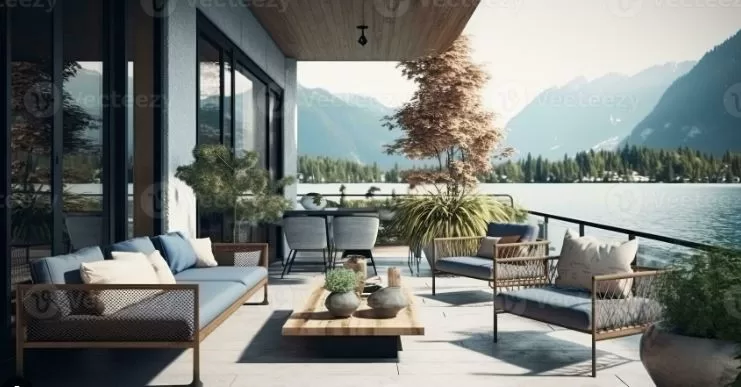
10. Pop-Up and Hybrid Spaces
Flexibility and adaptability are essential in 2024, as restaurants experiment with different concepts and formats. Hybrid spaces that can be transformed for various purposes are becoming more common, allowing restaurants to cater to a wider range of customers and events.
-
Pop-Up Concepts: Pop-up restaurants or temporary dining installations are becoming increasingly popular as a way to keep the dining experience fresh and exciting. Hybrid spaces that can host pop-up events or change themes regularly allow restaurants to experiment with new menus or design concepts without committing to a permanent overhaul.
-
Transformable Interiors: Some restaurants are designed to easily transition from casual daytime settings to more formal evening environments. This can be achieved through changes in lighting, furniture arrangement, or even the use of movable walls or curtains to section off different areas of the restaurant.
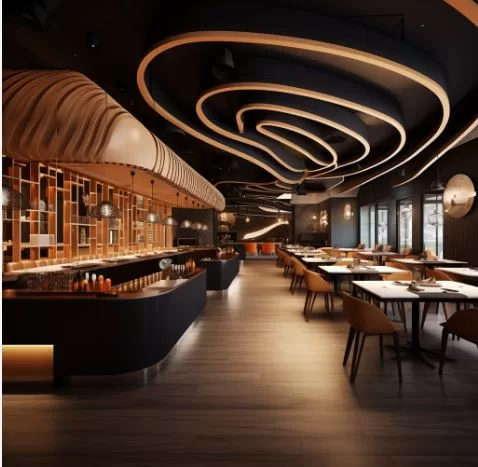
11. Storytelling Through Design
Finally, in 2024, many restaurants are focusing on storytelling as a central element of their design. Whether it’s telling the story of the chef, the food, or the local community, restaurants are using design to create a narrative that enhances the dining experience.
-
Cultural and Local Influence: Restaurants are incorporating design elements that reflect the local culture or heritage, using materials, artwork, and decor that tell a story about the region. For example, a coastal restaurant might use nautical-inspired decor, while a farm-to-table establishment might feature rustic, agricultural elements.
-
Chef-Centric Design: In some cases, the design of the restaurant is centered around the chef’s personal story or culinary philosophy. This might be reflected in the layout of the kitchen, the materials used, or even the overall theme of the restaurant. By telling the story of the chef, restaurants can create a more personal connection with diners.
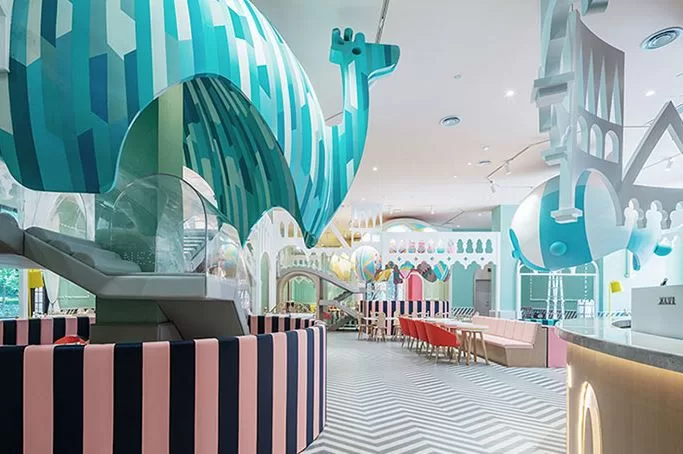
conclusion
In conclusion, restaurant design in 2024 is all about creating spaces that are not only visually stunning but also engaging, comfortable, and sustainable. Whether it’s through the use of eco-friendly materials, bold color choices, or innovative technologies, the goal is to provide diners with a memorable experience that goes beyond just food. By blending aesthetics with functionality and storytelling, restaurant designers are shaping the future of dining in a way that is both exciting and responsible.
About Author sudeshna mukherjee
You May Also Like…
The Ultimate Guide to Hiring a Consultant Chef
Introduction Food trucks or mobile food trucks is an idea that has arrived. But, there is a issues with food safety in...
Food Safety Essentials: Addressing 5 Common Problems in Food Trucks
Introduction Food trucks or mobile food trucks is an idea that has arrived. But, there is a issues with food safety in...

